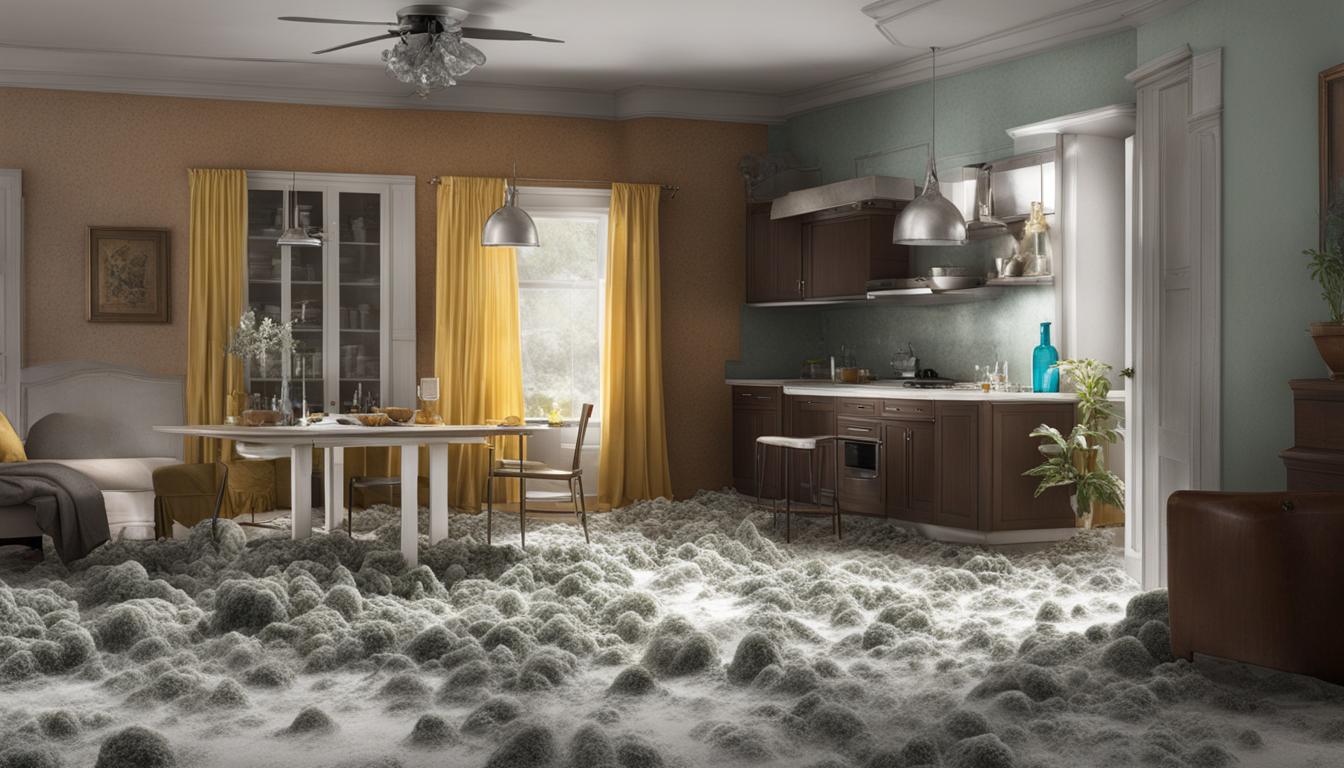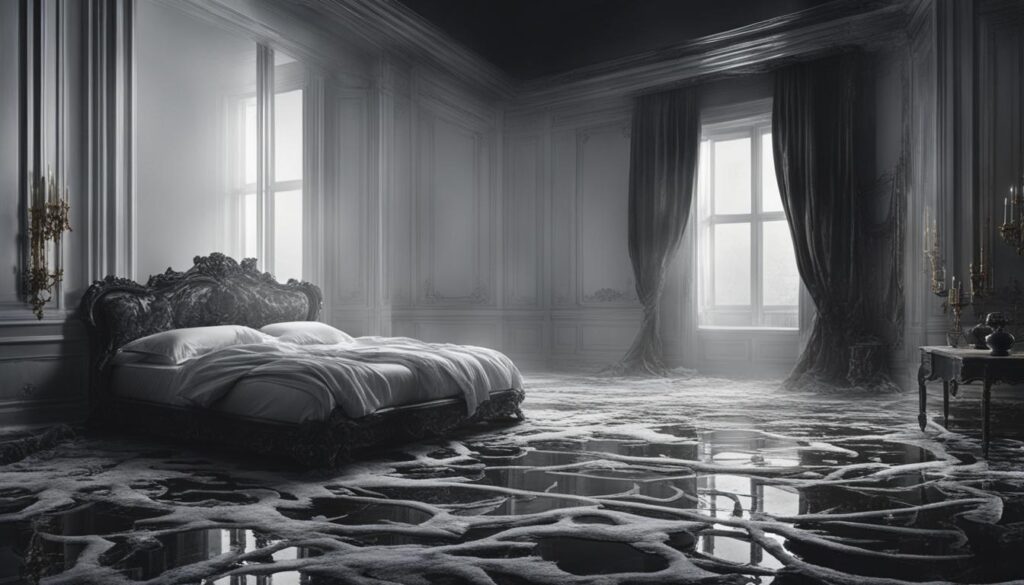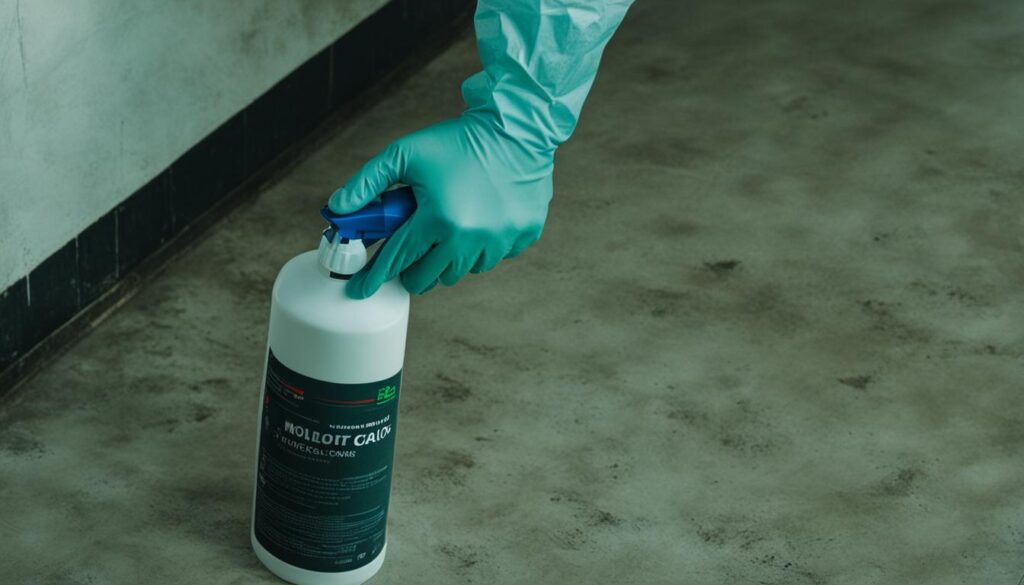
Understanding White Mold: Risks & Removal Tips
If you’ve noticed a white, fuzzy growth in your home, it could be white mold. White mold can pose health risks and cause damage to your property, so it’s important to understand how to identify, remove, and prevent it effectively.
Key Takeaways
- White mold can pose health risks and cause property damage if not addressed.
- Proper identification and removal techniques can help mitigate the risks of white mold.
- Preventing white mold involves controlling moisture and ensuring proper ventilation.
- In complex cases or for peace of mind, seeking professional mold removal services is recommended.
- By following the tips provided in this article, you can effectively address white mold issues in your home.
What is White Mold?
White mold is a type of fungus that can grow on various surfaces, including soil, plants, and building materials. It is often found in damp and humid environments, making it a common problem for homeowners. White mold has a cotton-like or powdery appearance and can be mistaken for efflorescence or other types of mold.
The characteristics of white mold include its color, texture, and growth pattern. White mold is typically white or light gray in color and has a fluffy or powdery texture. It can form circular or irregular colonies on surfaces and produce a musty odor.
Awareness of the definition and characteristics of white mold is essential in identifying and effectively addressing this problem in your home’s environment. This is important because exposure to white mold can cause health problems such as respiratory issues and allergies.
“White mold is often found in damp and humid environments, making it a common problem for homeowners.”
Identifying White Mold
Identifying white mold can be tricky, as it often appears similar to other types of mold. However, there are some key signs and symptoms to watch out for:
- Appearance: White mold typically appears as a white or grayish patch on surfaces. It may also have a fuzzy or powdery texture.
- Odor: Like other types of mold, white mold has a musty odor that can help with identification.
- Moisture: White mold tends to grow in damp or humid environments, so it’s commonly found in areas like basements, attics, bathrooms, and kitchens with poor ventilation.
Common areas where white mold tends to grow include:
- Basements and crawl spaces with moisture problems.
- Attics with poor ventilation or roof leaks.
- Bathrooms with inadequate ventilation and high humidity.
- Kitchens with poor ventilation and plumbing leaks.
If you suspect that you have white mold in your home, it’s important to take action as soon as possible to prevent it from spreading further.
Health Risks of White Mold
Exposure to white mold can lead to serious health issues, especially for people with weakened immune systems or respiratory conditions such as asthma. White mold spores can trigger allergic reactions, including sneezing, runny nose, eye irritation, skin rashes, and in severe cases, respiratory distress.
Long-term exposure to white mold can cause chronic health conditions, so it’s essential to take immediate action if you suspect that your home is affected.
If you’re experiencing any symptoms of mold exposure, seek medical attention immediately. Medical professionals can administer tests to determine whether you have any mold-related health issues and provide appropriate treatment.

“Exposure to white mold can have serious consequences on our health. If you suspect that your home is affected by white mold, seek immediate assistance and take steps to remove and prevent it.”
White Mold on Walls and Surfaces
White mold can grow on almost any surface, including walls, floors, ceilings, and fabrics. It thrives in moist, warm, and poorly ventilated areas of your home, making it vital for homeowners to identify and manage it swiftly.
When left unchecked, white mold can compromise the structural integrity of your walls and surfaces, leading to costly repairs and health hazards. Here are some strategies to identify and address white mold on walls and surfaces:
Identifying White Mold on Walls and Surfaces
Before tackling white mold on walls or surfaces, it is essential to identify it correctly. White mold on walls and surfaces is characterized by a fluffy white or grey appearance. It is also commonly accompanied by a musty, earthy odour.
Check areas with poor ventilation, including bathrooms, kitchens, and basements, for white mold growth. It commonly grows on drywall, wood, tiles, and insulation materials.
Removing White Mold on Walls and Surfaces
When removing white mold from walls and surfaces, it is crucial to protect yourself from exposure. Wear goggles, gloves, and a dust mask to limit inhalation.
For smaller patches of white mold, clean the affected area with a mixture of water and mild detergent. Dry the area thoroughly to prevent regrowth. For significant infestations or widespread growth, it may be necessary to consult a professional mold remediation service.
To fix the source of moisture, remove all sources of water intrusion and ensure proper ventilation is established to eliminate future growth.
Preventing White Mold on Walls and Surfaces
The best way to prevent white mold growth on walls and surfaces is to address moisture control issues promptly. Inspect your home for sources of moisture, including leaks, condensation, or poor ventilation. Address any problems immediately to prevent mold growth.
You can also reduce the likelihood of white mold growth on walls and surfaces by regularly cleaning and maintaining your HVAC system, reducing indoor humidity levels, and keeping indoor air moving with proper ventilation.
Removing White Mold
When white mold is present in your home, it’s important to proceed with caution when removing it to minimize health risks. Here are some step-by-step removal tips:
Step 1: Protect Yourself
Wear protective gear, such as gloves, a mask, and eye goggles to avoid direct contact with mold spores.
Step 2: Isolate the Affected Area
Close all doors and windows to avoid spreading the mold spores to other areas of your home.
Step 3: Clean the Area
Begin by removing any visible mold using a scrub brush and a mold-killing solution. Then, use a vacuum cleaner with a HEPA filter to remove any remaining mold spores.
Step 4: Dry the Area
Once the mold has been removed, ensure the area is completely dry to prevent future mold growth. Use a dehumidifier or fans to speed up the drying process.
Step 5: Dispose of Contaminated Materials
Any affected materials, such as carpets or insulation, should be carefully removed and disposed of properly to avoid spreading mold spores.
Remember, white mold removal can be a challenging task, so if you’re unsure of how to proceed, it’s best to seek the help of professionals.
White Mold in Basements
Basements are one of the most common areas where white mold thrives due to their damp and poorly ventilated environment. Without proper care, basements can become a breeding ground for mold, causing health hazards and property damage.
Prevention is key when it comes to managing white mold in basements. Here are some effective tips to keep your basement white mold-free:
- Install a dehumidifier: Dehumidifiers help regulate moisture levels in the basement and reduce the risk of mold growth.
- Repair any leaks: Leaks in pipes or the foundation of the house can contribute to mold growth. Inspect your basement for any leaks and fix them promptly.
- Ensure proper ventilation: Ventilation is critical in moisture control and preventing mold growth. Keep windows open or install an exhaust fan to improve air circulation.
- Keep the basement clean and dry: Regularly clean and dry the basement to prevent the build-up of moisture and mold growth. Avoid storing damp items such as clothing or towels in the basement.
For existing white mold cases, it’s important to take swift and safe action. Here are some steps you can take to address white mold in your basement:
- Wear protective gear: Mold can cause health problems, so it’s important to wear gloves, goggles, and a mask to protect yourself during the removal process.
- Clean and disinfect: Use a mold cleaner or a solution made from a mixture of water and distilled vinegar to clean and disinfect the affected areas.
- Replace damaged materials: If any materials are severely damaged by the mold, such as drywall or furniture, it’s important to replace them to prevent further mold growth.
Remember, mold prevention is key to keeping your basement mold-free. By following these simple prevention tips, you can minimize the risk of white mold growth and protect your health and your property.
White Mold in Attics
If you have an attic, it’s important to be aware of the risks of white mold growth. Attics are susceptible to moisture buildup, creating a breeding ground for white mold. Prevention is key to avoiding white mold infestations in your attic. Here are some tips:
- Inspect your roof for leaks: White mold thrives in damp environments. Regularly check your roof for any leaks that could cause excess moisture buildup.
- Improve ventilation: Add attic vents or fans to improve airflow and reduce moisture buildup.
- Control humidity levels: Use a dehumidifier to control humidity levels, keeping them between 30-50%.
- Monitor stored items: Avoid storing items that can trap moisture, such as cardboard boxes or clothes.
If you suspect white mold growth in your attic, it’s crucial to address it promptly to prevent further damage. Call a professional mold removal service like Fix Mold Miami to safely and effectively remove the mold.
Preventing White Mold
Preventing white mold growth is crucial to safeguarding your health and home. Here are effective strategies for preventing white mold growth in different areas of your home:
1. Control Moisture
Moisture control is essential in preventing white mold growth. Fix all water leaks and plumbing issues promptly. Ensure proper ventilation in areas prone to moisture buildup, such as bathrooms, kitchens, and laundry rooms.
2. Maintain Good Airflow
Good airflow helps prevent white mold growth. Keep air circulating throughout your home by using fans, opening windows, and maintaining moderate temperatures. Avoid excess humidity by keeping indoor humidity levels below 60%.
3. Use Mold-Resistant Products
Consider using mold-resistant paints, drywall, and insulation in your home, particularly in areas where moisture tends to accumulate. These products can help mitigate the risk of white mold growth.
4. Keep Your Home Clean
Regular cleaning and disinfecting can help prevent white mold growth. Pay particular attention to areas where moisture accumulates, such as bathrooms and kitchens. Clean and dry any surfaces that get wet regularly.
5. Check Your HVAC System
Regularly inspect and maintain your HVAC system, including air ducts, filters, and vents. These areas can accumulate moisture and debris, creating conditions conducive to white mold growth. Consider professional cleaning and maintenance services to ensure your HVAC system stays mold-free.
Preventing white mold with proper moisture control and adequate ventilation
Professional White Mold Removal Services
For more complex white mold issues or if you prefer professional assistance, seeking the services of reputable mold removal experts like Fix Mold Miami can provide you with peace of mind. Our team of certified professionals uses advanced technology and proven techniques to identify and safely remove white mold from your home.
We offer comprehensive services, including:
| Service | Details |
|---|---|
| Inspection | Thorough inspection of your property to identify white mold and determine the best course of action. |
| Remediation | Safe and effective removal of white mold using industry-standard techniques and equipment. |
| Prevention | Expert guidance on how to prevent white mold from recurring in your home. |
We understand the importance of timely and reliable service, and we take pride in delivering high-quality solutions to our clients. If you suspect white mold in your home, don’t hesitate to contact Fix Mold Miami at 305-465-6653 and schedule an appointment today.

Conclusion
White mold is a serious issue that can cause health risks and property damage. Understanding the nature of white mold, identifying its signs and symptoms, and implementing proper removal and prevention techniques are crucial steps to keep you and your family safe. By taking the necessary measures, such as controlling moisture, ensuring proper ventilation, and seeking professional assistance when needed, you can effectively manage white mold issues in your home.
If you suspect the presence of white mold in your home and need professional help, contact Fix Mold Miami at 305-465-6653 for reliable mold removal and prevention services. Don’t let white mold compromise your health and property. Take action today to ensure a safe and healthy living environment for you and your loved ones.
FAQ
What is white mold?
White mold is a type of fungal growth that appears as a white or grayish substance. It is commonly found in damp and humid environments, and can pose health risks and cause property damage if left untreated.
How can I identify white mold?
White mold can be identified by its white or grayish color and fuzzy or powdery texture. It may also have a musty odor. Common areas where white mold tends to grow include basements, attics, and on walls and surfaces.
What are the health risks of white mold?
Exposure to white mold can lead to various health issues, especially for individuals with respiratory conditions or weakened immune systems. Symptoms may include coughing, wheezing, allergies, and respiratory infections.
How do I remove white mold?
To safely remove white mold, start by wearing protective gear such as gloves, goggles, and a mask. Then, clean the affected area using a solution of bleach and water, scrubbing the mold off the surface. It is important to fix the underlying moisture issue to prevent future mold growth.
How can I prevent white mold?
Preventing white mold involves controlling moisture levels in your home. Ensure proper ventilation, fix any leaks or water damage promptly, and use dehumidifiers in damp areas. Regularly inspect and clean areas prone to mold growth, such as basements and attics.
What should I do if I have white mold in my basement?
If you have white mold in your basement, it is important to address it promptly. Begin by identifying and fixing any sources of moisture, such as leaking pipes or inadequate drainage. Clean the mold using a bleach and water solution, and consider using dehumidifiers to control humidity in the area.
How can I prevent white mold in my attic?
To prevent white mold in your attic, ensure proper insulation and ventilation. Seal any gaps or cracks that may allow moisture to enter, and regularly check your attic for signs of leaks or condensation. Properly and promptly addressing any moisture issues will help prevent white mold growth.
What are some professional white mold removal services?
If you prefer professional assistance or have a complex white mold issue, reputable mold removal experts like Fix Mold Miami can provide specialized services. Contact Fix Mold Miami at 305-465-6653 for professional assistance and peace of mind.
What are the risks of white mold on walls and surfaces?
White mold on walls and surfaces can spread rapidly and cause damage to the structural integrity of your home. Additionally, it can contribute to poor indoor air quality and pose health risks for occupants. Promptly identifying and addressing white mold on walls and surfaces is crucial.
What are the key steps to preventing white mold?
Preventing white mold involves managing moisture levels and reducing humidity in your home. This can be achieved through proper ventilation, regular cleaning and maintenance, fixing leaks promptly, and using dehumidifiers in areas prone to excess moisture.




